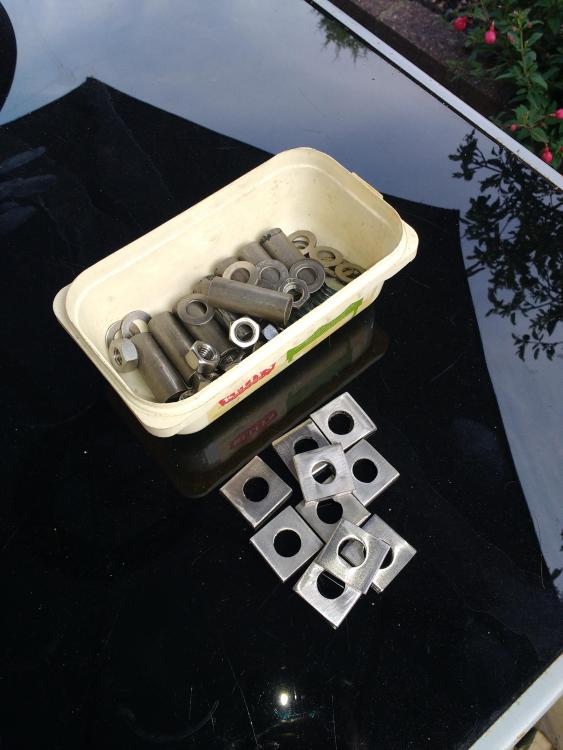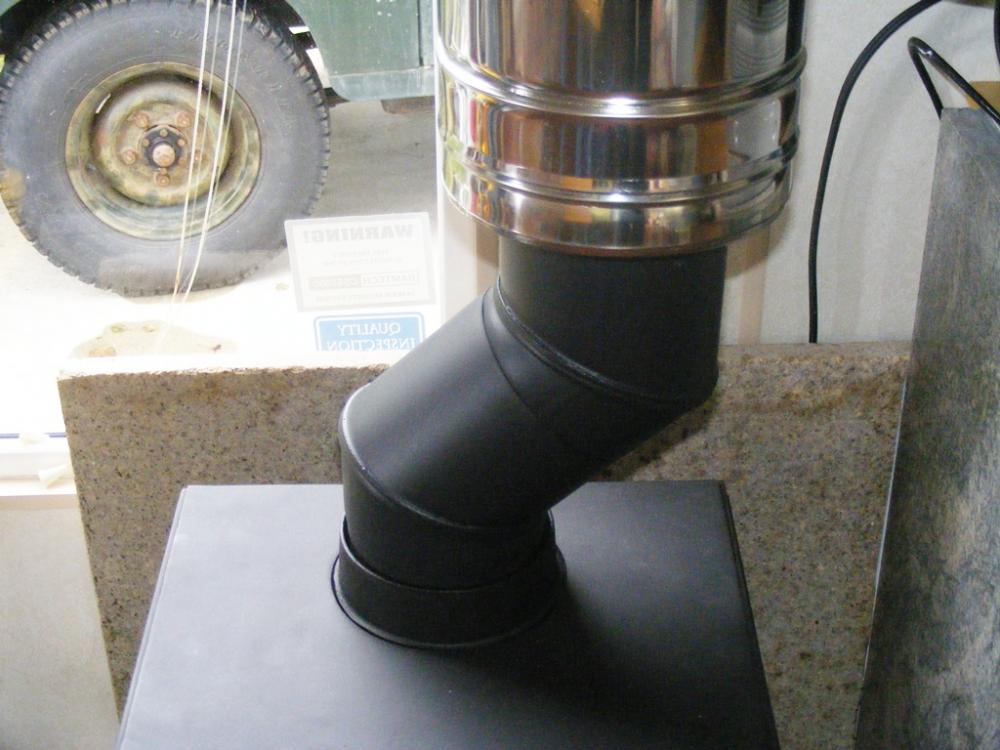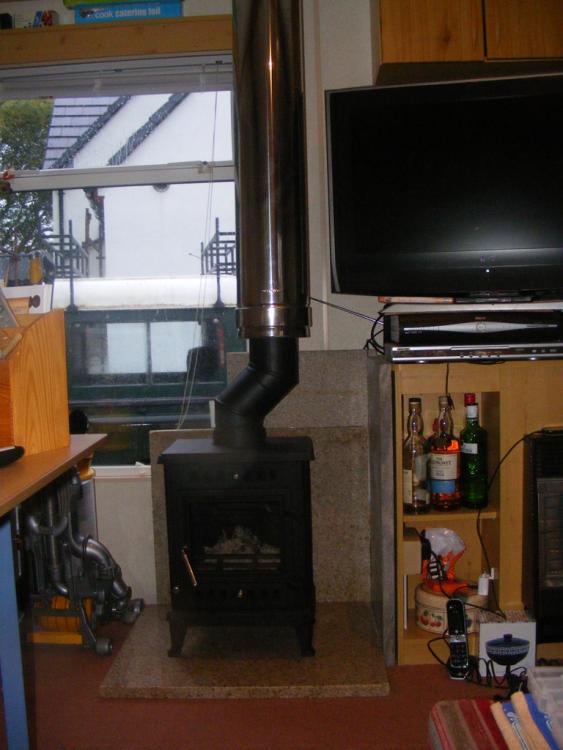Leaderboard
Popular Content
Showing content with the highest reputation on 07/13/22 in all areas
-
I don't see any issue, yes voltage can be high, yes it could kill you, but as long as your not being blinking daft you will be fine. Wire up all the fixed stuff from the mains connection to the DC isolator, that can all be done safely with full isolation. Then wire up your DC cables into your isolator(s) BEFORE they are connected at the other end to the panels, then with the DC isolator(s) OFF, you connect the solar string(s) - at this stage no load will be on the panels so no current shall be flowing, so no arcing or sparking and the circuit will be open so there won't even be a spark, carefully, without sticking your tongue and pinky finger into the ends of the MC4 connectors, push them together until they click. You can now fire up your system, usually AC on first, then DC side - but follow manufacturers instructions for first power up. I know my inverters are different, 1 will do nothing until it sees DC, so commissioning during the night or without PV connected is actually impossible (unless you have a string emulator), the other will fire up and just go into sleep mode. Look at it this way, how many PV installers work at night?3 points
-
Hi, As a small step towards repaying the valuable advice I have received on this forum I thought I'd share the attached document, which I hope will be useful and/or interesting to forum users. I am a planner by trade, working in local authority. My SB is on a relatively small, highly inaccessible plot neighboured by mature trees, and tightly bordered by existing houses. The plot was a 'detached' back garden of sorts that came as part of the deal (and something of an afterthought) when we bought our current house. Nobody had ever even considered the prospect that it could be a building plot, and for many years I discounted the idea myself due to the restrictions listed above. Five years ago, having outgrown our house and exhausted other options, I decided to at least try to self build on the plot. I obtained permission at the first time of asking (albeit not quickly and not without having to make a tweak or two). Everyone, without exception, from family to neighbours to building tradesmen to delivery drivers to other planners, have commented on how 'well' I've done to get permission. Some of them probably thought I'd made a mistake, or that the Council did, or that there was some old pals act involved because I am a planner myself (even though I don't work in the borough where I am building, and it really, really doesn't work that way anyway). They are all wrong. I obtained permission because I did the thing that planners spend their working lives telling others to do - I read the relevant planning policies, designed a development that was in line with them, then demonstrated as much in the application. That is what the attached statement does, it goes from global to national to regional to local policy, then explains the thought process behind my design, in that context. I cannot tell you how many architects, developers and would-be planning consultants fail to design development proposals specifically to meet planning policies, and then spend ages moaning, appealing, resubmitting, and generally wasting time. I can't promise that if you follow the thought process in my document you'll certainly get planning permission, but I hope you find it a useful insight into how a planner approached self-build, and specifically the matter of seeking planning permission on a plot that the rest of the world had discounted. Cheers 647910914_DesignandAccessStatementRedacted.pdf2 points
-
Yes that is in principle how it works. you must terminate the cables in the DC isolator first. Then you must confirm insulation resistance between DC cables is good, i.e. you have no damaged cable no nails through the cable and most important have not messed up the wiring of the isolator and created a short circuit. Then lock the isolator in the off position. Then plugging in the panels one at a time in series should be safe, but I still prefer to do the last connection at dusk when the output from the panels will be small. Remember DC is much more dangerous. The alternating nature of ac will likely throw you off if you touch something. DC won't do that so is far more likely to be very serious. 250V dc is not something you want to touch.2 points
-
2 points
-
I’m pretty sure supply will outstrip demand very soon If it isn’t the case already We have had a sign up at the plots with my name and contact details on for the last six months and up and till three weeks ago no calls from the usual reps This past two weeks I’ve been contacted by 2 kitchen companies 1 window company 3 timber -builders merchants and a GSHP company our Joist suppliers have contacted me regarding ordering the roof Lead times down from 8 weeks to 2 weeks Pasquils have asked if they could re quote This is a massive contrast to six months ago when it was taking several weeks to get a response to an email enquiry1 point
-
Glad to see some people have found the statement useful. Something I didn't explain in my original post but which may be apparent anyway, is that once I had a good idea of my preferred design I asked myself: 'If I was the planner assessing this, and if I was being as harsh as I could reasonably be, what would be the specific grounds on which I could refuse it?' The statement is partly an exercise in anticipating those possible grounds of refusal and addressing them in advance. That is easier for me as a planner than for many others, but it's not rocket science. Look at the adopted policies and supplementary guidance on the council website, and read the planning officers report for a few applications in your area to get a feel for how those policies are applied. You'll find that you get the gist pretty quickly, even if you've never looked at a planning policy before. Its not impossible to discuss and debate your plans once they are submitted (though it is increasingly rare to get the chance), but really the idea is to make the most substantive and comprehensive case upfront. It is for the applicant to support their proposal, not for the council to tease out everything that is good about your idea. Ultimately of course, if you've designed something that obviously doesn't meet the policies then it doesn't matter how thoroughly you state your case. Equally, if you've got a design which plainly meets every criteria then you shouldn't need to sell it to the planning office. Most plans sit somewhere in the middle of those two extremes, where there is inevitably a degree of subjectivity, so put the work in to show the extent of compliance with planning policies as part and parcel of your application. You do of course get the odd stroppy or difficult planner, but not half as often as you get a stroppy or difficult applicant! However frustrated you might get, remember that there is a significant difference between making an argument and having one.1 point
-
Leaving aside your repeated turning of my mighty thread into a soft **** movie, you should be grateful for the more intelligent female half of the inhabitants of Bristol. If you had to wear something with that many interlinked straps, you'd be like a kitten with a ball of string, and would probably end up hanging yourself from the ceiling hook without even needing any help from the local dominatrix. Edit (Ooops. Did I just say that out loud?)1 point
-
1 point
-
1 point
-
If youre looking for a solar experienced spark you might be waiting a while!! In the meantime, with a 2kw inverter, you could plug your inverter into the nearest 13amp socket to get it powered up for testing. Not that Im endorsing it, but you could then leave it plugged in to grab some generation while the sun shines:)1 point
-
I had a look at your plans and would have a rethink... You are extending sideways 2.57m probably giving a room only 2.2m by the time you subtract the thickness of the walls. They are also on the side which already has small rooms like the WC and Utility Room. Are you planning to knock through into the extension to make them bigger? Likewise the rear extension. You suggest 2-3m. Seems like a lot of work for just 2m unless you are planning to knock through. A knock through at both back and sides is possible but it's quite expensive and you certainly need a builder that's done it before due to the risk. A structural engineer also needed. I think I would look at a wider side extension so rooms there are big enough without a knock through? And perhaps a deeper conservatory or sun room on the back of the kitchen/dining room under Permitted DeDevelopmentas it's detached you can extend back 4m no problem and upto 8m 8f neighbours are happy under the consultation scheme.1 point
-
Heh yep. But the video actually touched on many items including the in-door icecube makers. I will have to do some soul searching on how important it is to my life. As you can imagine in the current week of 27+C temps expected, being able to get a glass of chilled+iced water without opening the fridge and rummaging around with the ice tray is .. nice. But then again, an ice compartment with a small but easily accessible scoop might be not much worse, and much more energy efficient....1 point
-
Don't forget when playing with Octopus's forecast you WANT that forecast to be in arrears by about March 2023 by about £400 as their prediction is not showing the £400 the government is going to pay into your account between Octomer 2022 and March 20231 point
-
I'm struggling with the Yank term "French Door Refrigerators". Which are the ones we call "American Fridges".1 point
-
Sorry but it's still not 100% clear if it is a Party Wall as defined in the Party Wall Act. This matters.. 1) If the wall is entirely on your side of the boundary is unlikely to be a party wall. Your permission is required for anything they want to do to it. 2) If the wall straddles the boundary it will be a party wall. In which case you would have needed permission from the neighbour to build this wall. More info here.. https://www.gov.uk/government/publications/preventing-and-resolving-disputes-in-relation-to-party-walls/the-party-wall-etc-act-1996-explanatory-booklet So assuming it is Party Wall or a Party Fence Wall under the Act then the issue is do they need your permission... Doing some work on or near the wall would require the party doing the work to comply with the Act. For example cutting a hole in it to insert a steel beam would require following the Act. The procedure is in The Guide to the Party Wall Act above. However the guide also says.... I think it's unlikely that what they want to do would be covered by the Act. However even if it was covered by the Act they still wouldn't need your permission. All they would need to do is comply with the Act. The cheapest way to do that would be to get your permission but if you refuse they could employ a surveyor to draw up an agreement which you can't refuse. Be careful about refusing permission because if it's a Party Wall then you may need their permission later to do work on the wall even though you built it.1 point
-
Another option is to heat via a Willis immersion, they connect to bottom and top of tank, supposedly can heat just the top or the whole tank, no external pumps needed..1 point
-
If all of the wall is on your land they do not have the right to attach anything to it.1 point
-
Would MOT type 1 just block everything up as it has lots of fines in the mix. Gravel or pea would be my thoughts1 point
-
Difficult to say from this pic but looks like a membrane, Can’t see it being felt at that width so more likely a rubberised or PVC type membrane1 point
-
I agree, I would work from the AC end backward towards the panels, testing as you go, connecting the panels up last (with insulated plugs). (I plan a DIY instal later this year).1 point
-
Got it and the gurgling noise has disappeared. So thank you. What surprised me was that the plumber (a gas safe one) had no idea how to solve this issue. But then again, I am coming across too many tradesmen who are not that good.1 point
-
I'm pretty much with you on this. I wired up all my panels myself, you would have to be doing something very wrong to get a shock. It's easy to do and as long as you are careful I'm not sure what the issue is🤷♂️1 point
-
Document it all so we can see what is involved. Be an interesting project. May even post you one of my homemade energy loggers, could be useful data.1 point
-
@SteamyTea I Think you've done your bit to save the planet, quick call and a local refrigeration guy will connect for £120. If I do the install work... cheaper than buying the twin wall and heat deflectors.. and I can sleep easy at night knowing that my heating is green. ( gas fired / nuclear / coal electricity🙈)1 point
-
I fitted a 5kW WBS to my static 'van. I fitted it alongside rather than in place of the gas fire. I had several stone slabs I picked up from freecycle, all offcuts of stone worktops of differing thicknesses and sizes and made them work as a hearth and a surround. The kink in the flue was so the twin wall went between the roof trusses and keep it to one side of the window. an important (I think) detail is there is a small gap left between the stone sides and the wooden wall they are protecting. It worked very well and kept us warm through the winter with the "beast from the east" but it was a challenge feeding it with wood. We lit it in November and it hardly went out until March. We put coal on over night to keep it in. The wood was free as we had taken down a number of young trees to clear the plot.1 point
-
Are they optimised? If not, beware of getting frazzled installing these during the daytime. The real risk is going + to - per panel in sunlight, or the then elevated risk of connecting a string and getting quite high DC available across the sum of the string. Pretty serious, life changing juice available per string. If you make the single core DC cables off to the rotary isolator first, then lock the isolator in the off position, and work back from there up panel by panel you will reduce the risk ( not eliminate it ). If you have any doubt, please do not carry out this work.1 point
-
1 point
-
Please could the Mods consider pinning this post / thread Ian I ask because the Design Access Statement is a model of Brevity Focused argument Well-structured content Good use of images Evidence-based discussion Clearly produced maps and an excellent written style1 point
-
Your invention and time make @Onoff ‘s efforts look tame . You are the new God .1 point
-
I was taught that must indicates a legal requirement that is enforceable, can indicates a guideline, and will is ambiguous, and usually deliberately so to lead people to think that something is a requirement when it is not...1 point
-
You have to buy a trap with the AAV built in, sometimes called a silent trap. e.g. https://www.screwfix.com/p/mcalpine-swivel-p-trap-white-40mm/50408 But that won't fit, you need a telescopic P trap with the AAV, I have not found one yet.1 point
-
Well, it is published as a "Guide" after all 😃 I went nuts trying to tie down the legal requirements for self-installers but a parallel search for cases where people were being prosecuted for not abiding by the "difficult to determine" regulations came up empty handed too - so draw your own conclusions. Part P is obviously a "must" for any new circuit though.1 point
-
I would leave out the timber as this will rot leading to sinkage but anything else (non contaminating).1 point
-
No, put rubble, bricks, sand, stone etc. in it, site scrapings, whatever, build it up, job done. My back garden had a huge hole dug about 12' deep and 10' wide/long and we put most of our old garage in it, timber, brick, render, then all the site scrapings and nonsense. Each layer was tamped in with the excavator and run over and hosed too at various points to help compact it all, 4 years on there has maybe 1-2" max drop in the lawn at that point which I build up with sharp sand and top soil. My attitude is just don't put any plastics or glass or painted things etc. in it as my feeling is it will breakdown and enter the groundwater over time.1 point
-
Don't be in a hurry to fill it in straight away. It sounds like a handy place to lose all hardcore, rocks and anything else solid and inert that you need to get rid of when you start building.1 point
-
How old is the house, does it have an existing DPC? We had similar problems with our 1850's house without a physical DPC. All advice we received was to excavate and lay a slab. Micro digger and dumper in to excavate then 150mm MOT 1, 25mm sand, 100mm Conc, 100mm PIR and 60mm screed. We were also rewiring at the time, so dropped all our services from above to avoid ducting within the floor itself. We did most the work ourselves and it was messy, uninhabitable during that time. It would have probably have been cheaper to replace the joists when DIYing, certainly not so when paying a contractor. Since we did ours, others have raised concern regarding a new slab with a DPM potentially pushing moisture to the perimeter and therefore up the walls (without a DPC). Those concerns haven't come to any realisation (yet...) (FWIW, if I was to do it again I'd probably go 150mm MOT 1, 250mm EPS (50mm as a sand blinding), finished with a 100mm conc reinforced slab instead. Slightly deeper but better thermal properties and arguably cheaper than PIR + conc + screed.1 point
-
0 points
-
I’ve been competent with complex 1ph and 3ph electrical design and installation projects, in both the domestic and the marine environment, and am taking delivery of my own panels imminently. I’ll be completely honest, even MY arse is twitching over the DC-related-death likelihood. I’ve had more AC shocks than I can remember ( memory loss probably caused by these lol ) and only one got me worried, but DC is a different beast altogether. As an aside; It would be such a shame to die now, as my children are 11, 13, 15 and 18 years of age now, and over the last few months I’ve started to become quite fond of them…….0 points
-
0 points
-
But inert crap, rubble and stuff! Not stuff that will contaminate the soil.0 points



















